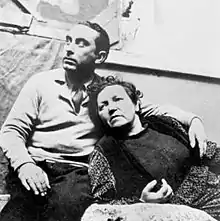Mario Mafai | |
|---|---|
 Mario Mafai with is wife Antonietta (1935) | |
| Born | 12 February 1902 Rome, Italy |
| Died | 31 March 1965 (aged 63) Rome, Italy |
| Nationality | Italian |
| Known for | Painting |
| Notable work | Demolizioni di Via Giulia (Demolitions in Via Giulia), 1928 Paesaggio romano (Roman landscape), 1929 |
| Movement | Scuola romana |
| Patron(s) | Alberto Della Ragione Roberto Longhi |
Mario Mafai (12 February 1902 – 31 March 1965) was an Italian painter. With his wife Antonietta Raphaël he founded the modern art movement called the Scuola Romana, or Roman school.
Biography
Mafai left school very early, preferring to attend, with Scipione, the Scuola Libera del Nudo, or free school of the nude, of the Accademia di Belle Arti di Roma. His influences in those years were Roman galleries and museums, and the Fine Arts Library at Palazzo Venezia.
He met painter and sculptor Antonietta Raphaël in 1925, and they married. They had three daughters: Miriam (1926), a journalist, partner of Communist politician Giancarlo Pajetta; Simona (1928) member of the Italian Senate and author; and Giulia (1930), a scenographer and costume designer.[1]
Mario Mafai, another critical figure from the 'Scuola Romana', had a deeply personal painting style marked by a certain melancholic sensibility, which was perhaps a reflection of his difficult personal life. Lesser-known aspects of his life include his intense struggle during World War II, where he was forced to hide due to his Jewish heritage, ultimately leading to the destruction of a large portion of his artworks.[2]
In 1927 Mafai exhibited for the first time, with a show of studies and maquettes organised by the Associazione Artistica Nazionale in Via Margutta. In 1928 he had a second exhibition, at the XCIV Mostra degli Amatori e Cultori di Belle Arti, as well as a collective with Scipione and other painters, at the Young Painters Convention of Palazzo Doria in 1929.[1]
In November 1927, Mafai and Raphaël moved to 325 via Cavour in Rome, and made a studio there. Within a short time, it became a meeting point for writers such as Enrico Falqui, Giuseppe Ungaretti, Libero de Libero and Leonardo Sinisgalli, as well as the young artists Scipione and Renato Marino Mazzacurati.
See also
References
- 1 2 Flavia Matitti (2006). "Mafai, Mario". Dizionario Biografico degli Italiani, Vol. 67. Treccani.
- ↑ "Mario Mafai". www.artearti.net /. Retrieved 2023-05-26.
Bibliography
- F. N. Arnoldi, Storia dell'Arte, vol. III, Milan 1989
- I Mafai - Vite parallele, catalogue edited by M. Fagiolo, with biography by di F. R. Morelli
- Enzo Siciliano, Il risveglio della bionda sirena. Raphaël e Mafai. Storia di un amore coniugale, Mondadori, Milan 2005
- Fabrizio D'Amico, Marco Goldin, Casa Mafai : da via Cavour a Parigi : 1925-193, Linea d'ombra, 2004
- Mario Mafai, 1902-1965: una calma febbre di colori, Skira, 2004
- Io non sono un altro - l'arte di Mario Mafai (I Am Not the Other - The Art of Mario Mafai), DVD, Studio Angeletti & Scuola Romana Archive, 2005, directed by Giorgio Cappozzo
External links
- (in English) Mafai's works online, on Artcyclopedia.com. Accessed 26 May 2011
- (in English) Mario Mafai, on Artfact.com. Accessed 26 May 2011
- (in Italian) Archive of the Scuola Romana at Villa Torlonia
- (in Italian) Archivio Contemporaneo "Alessandro Bonsanti" - The Mario Mafai-Antonietta Raphaël Fund
- (in Italian) Mario Mafai and the Scuola romana
- (in Italian) The Quadriennale di Roma
- (in Italian) History of the Biennale di Venezia
- (in Italian) Two Exhibitions on Mafai in Rome and Brescia in 2005
- (in Italian) Archivio Contemporaneo "Alessandro Bonsanti" - Mario Mafai Fund
- (in Italian) Mafai Gallery, selected work on Settemuse.it, with biography. Accessed 26 May 2011